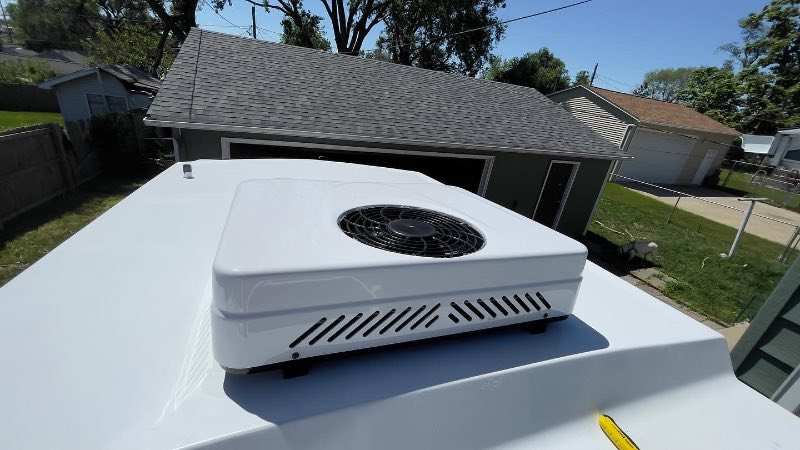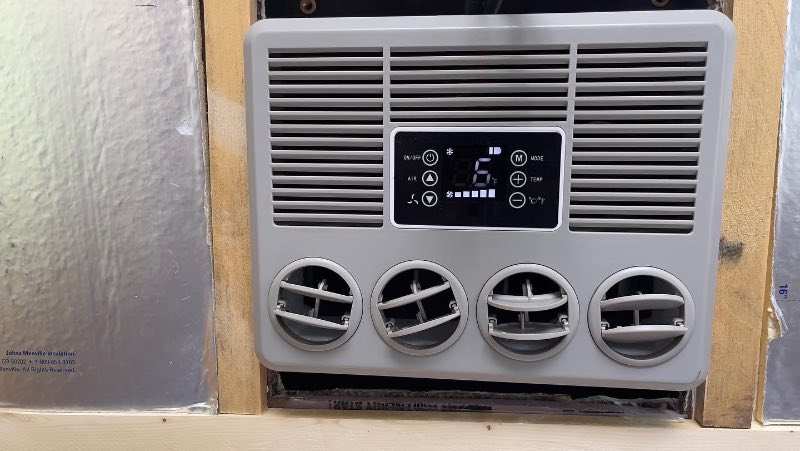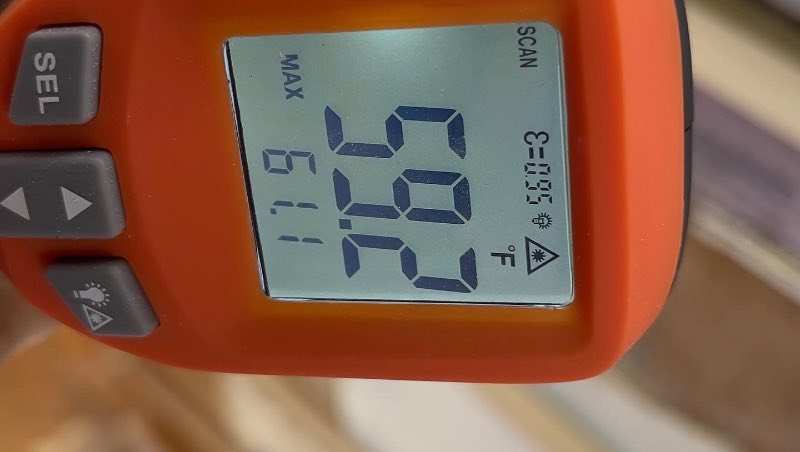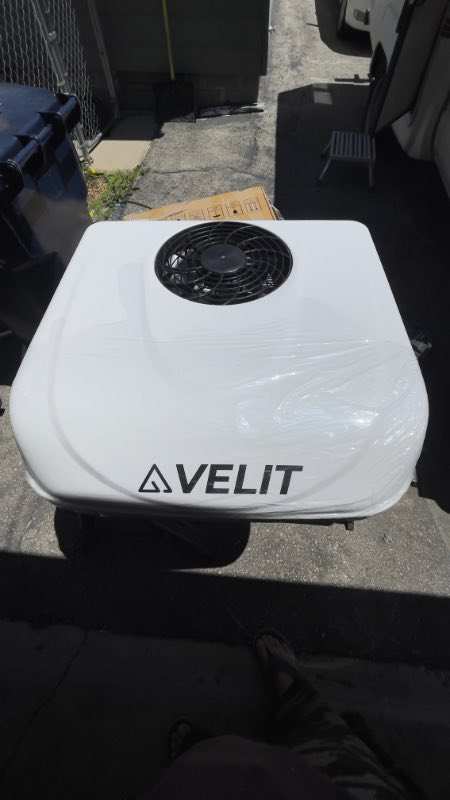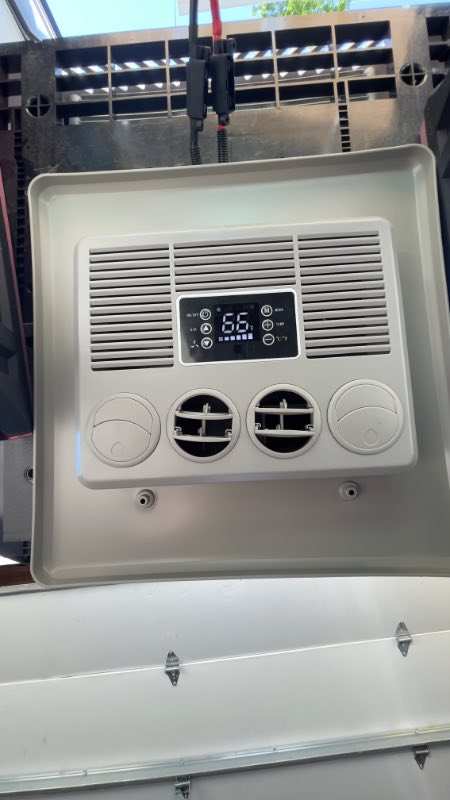
ChrisMichael
Members-
Posts
10 -
Joined
-
Last visited
Content Type
Events
Profiles
Forums
Gallery
Everything posted by ChrisMichael
-
I finally had enough days without rain that I could put a couple coats of primer and epoxy paint on my roof and install the rooftop A/C. It’s pretty light (for an A/C) at around 80lbs, but lifting it up on the roof by myself was still a bit of a chore. I temporarily hooked it up to a battery to give it a test. The outside temp was 95° here in Iowa. Inside the RV it was around 100°, and after about 10 minutes running on high it got down to about 85°. My inside is still gutted with no insulation and 2 missing windows, so I suspect this temp drop will be even better once those things get sorted out. I’m looking forward to getting everything tidied up and giving it a real test. The next step will be installing the solar panels, just after I finish painting the rest of the rig.
-
My sunrader is an 18’ rear dinette. I removed the shower and fiberglassed the hole for the 2nd fan/vent over, so the top panel will be covering the area where the vent used to be. There will be 2” of space between where the panel ends and the air conditioner begins. Haha. I’m keeping the toilet and making a bench that opens and the countertop lifts up to hide it, and running cabinets along the top whole length of the driver’s side all the way to the cabover. I’ll probably make some kind of curtain system to go around the toilet. Being 6’3”, I’ve never been able to use the shower in the past, or even really been able to fit inside the bathroom at all, but I couldn’t use the bathroom for storage because the toilet is so nice to have. I’m going to run an outside shower compartment on the passenger side rear where the water heater used to live. I’m replacing the water heater with a 1300W AC electric 2.5gal point of use water heater, which should provide enough water for a quick outdoor shower. The water heater supposedly recovers a full tank in 10-15 minutes, so it’ll require 17-30ah of battery to take a shower, which the solar panels should recover in less than an hour hopefully. I’m planning on just carrying along one of those foldable changing rooms to use as a portable shower stall. Unfortunately due to the weight and size of the panels, I don’t trust the VHB tape solution that I previously used on my 100W panels. I’m probably going to make some mounting brackets that will go into the side of the RV rather than the roof to lessen the chance of pooled water getting through the drilled holes.
-
Hi all. I finally got the Velit 12VDC Air Conditioner today. The first one they shipped me last week got destroyed by UPS and arrived leaking oil from the compressor. The shipper reinforced the box for the second attempt and it made it safely. I tested out the AC by setting it up on a couple of sawhorses and hooking it up to one of my LiFePO4 batteries. I wanted to make sure it worked before pulling my MaxxAir fan out and putting it up on the roof. The AC worked flawlessly and blew some really nice cold air on me from down below. It pulled about 50A while running on high, 25A while running on low, and 3A when just running the fan to circulate air. I recently found that Renogy is now making a 450W solar panel with a width dimension that is essentially just slightly less than the width of the top portion of my sunrader. I ordered two of these, one for the cabover section and one between the cabover and AC, so I’ll now have 900W of solar power, which should be enough to completely offset the AC while running on a Sunny day, with a little extra to keep the batteries charging. I’ll have essentially no other real estate on my roof, but I don’t really like getting up there anyways. Haha.
-
At the distance required to get from your battery to the A/C, then back again, 8 gauge copper would be really pushing the safety limit at 55A, even the 6 gauge wire they include seems a little iffy to me.
-
A circuit breaker rated for 20A will only work for current draws up to 20A, no matter if the voltage is 12V or 110V. So that circuit breaker can take 110V*20A=2200W at 110V, but it can only handle 12V*20A=240W at 12V before tripping. There are additional safety reasons why you wouldn’t want to use a circuit breaker rated for AC current instead of one rated for DC current though. The thickness of wire needed increases inversely proportional to the voltage needed to reach the same power (Wattage) yield because as your voltage decreases (110V -> 12V) your amperage must increase to make the same power, as typically shown by the formula P(Watts) = I(Amps) x V(Voltage). For your 110V 20A example producing 2200W, you would need 2200W / 12V = 183.3A of current to produce the same wattage at 12V. Amperage is what dictates the thickness of the wire needed for the most part, along with the voltage drop that occurs over longer runs at lower voltages compared to higher voltages. Trying to run this A/C on a #12 wire with a 20A circuit breaker would immediately trip the breaker, which is good because running it on a #12 wire with a properly sized circuit breaker would melt the wire and potentially start a fire.
-
I might have not stated what I meant clearly, but the wiring typically found up near the ceiling for an 110VAC powered air conditioner is only rated to about 15A. This unit, at 12VDC requires up to 700W, or ~60A. Pushing 60A through a wire only rated to 15A could very easily melt it and start a fire. You’d have to use the thicker 6AWG wiring that comes with the unit (it’s pre-fused at 80A too) in order to safely pull 60A of current at 12V from a battery bank within 15ft of the Air Conditioner. Any further and you’d need to step up to an even thicker cable.
-
I really like the low profile but wider profile of this compared to a traditional rooftop A/C as well. It’s shorter than my current MaxXAir fan with the shroud so anything I can do to reduce clearance is a bonus. Since my sunrader is currently gutted I’ll be reinforcing the ceiling anyways, but I think the wider profile will help distribute the 66lbs better to hopefully keep it from sagging. It also fits in a traditional 14”x14” hole whereas the Dometic RTX2000 requires making a larger hole. I guess the real question will be how long it’ll hold up since it’s a new product, but for over $1000 cheaper than the Dometic and not much more than a traditional rooftop A/C I’ll definitely take the gamble. I’ll post some pics of the install and testing when it arrives in a week or two. Since I do have my Sunrader gutted to the fiberglass it’ll be a lot easier to route the 6AWG cable that it requires. I think that might be a downside for someone with an already finished rig because there’s too much current draw to use the 110V wiring that’s already there.
-
Interesting update: I was browsing a VanLife forum this evening and found an engineer who is just putting onto market a dual inverter compressor 12V rooftop A/C with similar specs to the Dometic RTX 2000, but about $1000 cheaper. It’s 7000btu and pulls 20-60A depending on ambient temp and set points. It’s also got a fan only mode, which from my understanding isn’t the case on the Dometic. I decided to pull the trigger on this and do a test run. It should be here several weeks before EcoFlow Wave ships, so if all goes well I may just cancel the EcoFlow Wave order or try to resell it. Here’s a link to the A/C: https://velitcamping.com/products/velit-2000r-rooftop-air-conditioner-12v-24v
-
It pulls about 500W while compressor is on max A/C, 600-700W while compressor is on max A/C and charging the extra battery on AC power. It does have a 12V DC charging port, but it’s limited to 200W so it can’t run the compressor, only charge the extra battery and/or run in fan mode. According to some reviews, this drops to 400-450W if you were able to directly power over 48VDC, which can only be done if you also own a Delta Pro or Delta Max power station and use their proprietary cable. Since I bought the extra battery, it’ll give me ~2.5hrs of runtime (compressor running the whole time) by itself, and then I’ll likely just run it to my 3000W inverter with a switch for that circuit so that I can charge as needed. I have 300ah of 12V LiFePO4 batteries and 400W of solar panels, so I should be able to keep it going for quite awhile if needed. I plan on sticking mostly to climates where it isn’t blistering hot out, so this is more or less a little extra peace of mind if I have to leave my dog in the RV for a little while while I’m doing chores during the day or for helping to cool off in the evening before bed. It’s honestly not very efficient compared to installing a mini split, but I don’t really want to deal with the hassle of finding and fortifying space to mount everything with a mini.
-
I ordered this A/C with the 1kwhr battery unit. Their early bird pricing came out to be $1299 plus tax. I’ve currently got my sunrader gutted down to the fiberglass and plan on integrating it into the rebuild. The only downside I see is that the unit runs on 48V DC with a special cable that has some kind of communication protocol, so there’s no way to directly wire it to run off my LiFePO4 battery bank. I’ll have to plug it into my inverter and maybe wire a switch to connect/disconnect it when I need to charge the battery unit. I’ll give an update when I get everything setup.

